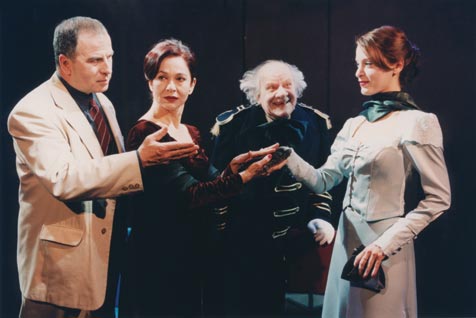
地獄とは他人のことだ
Huis clos or "L'enfer, c'est les autres"
or "Hell is other people"

☆ 『出口なし』(フランス語:Huis clos、発音:[ɥi klo])は、ジャン=ポール・サルトルによる1944年の実存主義的な戯曲。1944年5月にテアトル・デュ・ヴュー・コロンビエで初演された。この戯 曲は、3人の死者が永遠に1つの部屋に閉じ込められて罰を受けるという、死後の世界を描いた作品である。この戯曲は、サルトルの有名な言葉「地獄は他者で ある」の出典であり、他者の意識から自分を見ることによって生じる、自己を物として認識する永続的な存在の苦悩に関するサルトルの考えを表している。
| No Exit (French: Huis
clos, pronounced [ɥi klo]) is a 1944 existentialist French play by
Jean-Paul Sartre. The play was first performed at the Théâtre du
Vieux-Colombier in May 1944.[1] The play centers around a depiction of
the afterlife in which three deceased characters are punished by being
locked into a room together for eternity. It is the source of Sartre's
especially famous phrase "L'enfer, c'est les autres" or "Hell is other
people", a reference to Sartre's ideas about the look and the perpetual
ontological struggle of being caused to see oneself as an object from
the view of another consciousness.[2] English translations have also been performed under the titles In Camera, No Way Out, Vicious Circle, Behind Closed Doors, and Dead End. The original title, Huis clos ('closed door'), is the French equivalent of the legal term in camera (from Latin, 'in a chamber'), referring to a private discussion behind closed doors. |
『出口なし』(フランス語:Huis clos、発音:[ɥi
klo])は、ジャン=ポール・サルトルによる1944年の実存主義的な戯曲。1944年5月にテアトル・デュ・ヴュー・コロンビエで初演された。この戯
曲は、3人の死者が永遠に1つの部屋に閉じ込められて罰を受けるという、死後の世界を描いた作品である。この戯曲は、サルトルの有名な言葉「地獄は他者で
ある」の出典であり、他者の意識から自分を見ることによって生じる、自己を物として認識する永続的な存在の苦悩に関するサルトルの考えを表している。 英語訳は『In Camera』、『No Way Out』、『Vicious Circle』、『Behind Closed Doors』、『Dead End』などのタイトルで上演されている。原題の「Huis clos」(閉ざされた扉)は、閉ざされた扉の向こう側で行われる非公開の議論を指す、法用語「in camera」(ラテン語で「部屋の中で」の意)に相当するフランス語だ。 |
Plot Three damned souls, Joseph Garcin, Inèz Serrano, and Estelle Rigault, are brought to the same room in Hell and locked inside by a mysterious valet. They had all expected torture devices to punish them for eternity, but instead, find a plain room furnished in the style of the French "Second Empire". At first, none of them will admit the reason for their damnation: Garcin says that he was executed for being an outspoken pacifist, while Estelle insists that a mistake has been made; Inèz, however, is the only one to demand that they all stop lying to themselves and confess to their moral crimes. She refuses to believe that they have all ended up in the room by accident and soon realizes that they have been placed together to make each other miserable. She deduces that they are to be one another's torturers. Garcin suggests that they try to leave each other alone and to be silent, but Inèz starts to sing about execution and Estelle vainly wants to find a mirror to check on her appearance. Inèz tries to seduce Estelle by offering to be her "mirror" by telling her everything she sees but ends up frightening her instead. It is soon clear that Inèz is attracted to Estelle, Estelle is attracted to Garcin, and Garcin is not attracted to either of the two women. After arguing, they decide to confess to their crimes so they know what to expect from each other. Garcin cheated on and mistreated his wife, and was executed by firing squad for desertion; Inèz is a manipulative sadist who seduced her cousin's wife, Florence, while living with them and convinced her to leave her husband—the cousin was later hit and killed by a tram and Florence asphyxiated herself and Inèz by flooding the room with gas while they slept—and Estelle had an affair and then killed the resulting child, prompting the child's father to commit suicide. Despite their revelations, they continue to get on each other's nerves. Garcin finally begins giving in to the lascivious Estelle's escalating attempts to seduce him, which drives Inèz crazy. Garcin is constantly interrupted by his own guilt, however, and begs Estelle to tell him that he is not a coward for attempting to flee his country during wartime. While she complies, Inèz mockingly tells him that Estelle is just feigning attraction to him so that she can be with a man—any man. This causes Garcin to abruptly attempt an escape. After he repeatedly tries to open the door, it suddenly and inexplicably opens, but he is unable to bring himself to leave. The others remain as well. He says that he will not be saved until he can convince Inèz that he is not cowardly. She refuses to be persuaded, observing that he is obviously a coward and promising to make him miserable forever. Garcin concludes that, rather than torture devices or physical punishment, "hell is other people." Estelle tries to persevere in her seduction of Garcin, but he says that he cannot make love while Inèz is watching. Estelle, infuriated, picks up a paper knife and repeatedly stabs Inèz. Inèz chides Estelle, saying that they are all already dead, and even furiously stabs herself to prove that point. As Estelle begins to laugh hysterically at the idea of them being dead and trapped together forever, the others join in a prolonged fit of laughter before Garcin finally concludes, "Eh bien, continuons..." ("Oh well, let's continue..."). |
あらすじ 3人の呪われた魂、ジョセフ・ガルサン、イネス・セラーノ、エステル・リゴーが、地獄の同じ部屋に連れてこられ、謎の従者によって閉じ込められる。彼らは 皆、永遠の罰として拷問器具が用意されていると思っていたが、代わりに、フランスの「第二帝政」様式で装飾されたシンプルな部屋を見つける。最初は、誰も 自分の呪われた理由を認めようとしなかった。ガルシンは平和主義者として処刑されたと主張し、エステールは間違いがあったと主張する。しかし、イネズだけ は皆が自分に嘘をついていると主張し、道徳的な罪を告白するよう求める。彼女は、彼らが偶然その部屋に閉じ込められたと信じず、互いに苦痛を与えるために 一緒に置かれたと気づく。彼女は、彼らが互いの拷問者となるよう仕組まれたと推理する。 ガルシンは互いに放っておいて黙っているよう提案するが、イネズは処刑の歌を歌い始め、エスターは鏡を探して自分の姿を確認しようとして無駄な努力を重ね る。イネズはエスターに「鏡」になることを提案し、見たものを全て伝えることで誘惑しようとするが、逆に彼女を恐怖に陥れる。やがて、イネズはエステル に、エステルはガルシンに、ガルシンはどちらの女性にも惹かれていないことが明らかになる。 議論の末、彼らは互いの罪を告白し、相手から何を求めるべきかを知ることにする。ガルシンは妻を裏切り虐待し、逃亡罪で銃殺された;イネズは甥の妻フロレ ンスを誘惑し、 彼らと暮らしていた際にフロレンスを夫から離れるよう説得し、フロレンスはガスで部屋を充満させて自分とイネズを窒息死させた。フロレンスの従兄弟は後に 路面電車に轢かれて死亡した。一方、エスターは不倫をし、その子供を殺害し、子供の父親が自殺した。これらの暴露にもかかわらず、彼らは互いに神経を逆撫 でし続ける。ガルシンはついに、エスティールのますます過激になる誘惑に屈し始めるが、これはイネズを狂わせた。しかしガルシンは自身の罪悪感に常に妨げ られ、エスティールに「戦争中に祖国から逃れようとしたからといって、自分が臆病者ではないと」言ってくれと懇願する。彼女が従う間、イネズは嘲笑しなが ら、エスターはただ男と一緒になりたいから、彼に惹かれているふりをしているだけだと告げる。 これを受けてガルシンは突然逃走を試みる。何度もドアを開けようとするが、突然不可解にドアが開くも、彼は出る決心がつかない。他の者たちも残る。彼は、 イネズに自分が臆病ではないと説得するまで救われないと語る。イネズは説得を拒み、彼が明らかに臆病者だと指摘し、永遠に彼を不幸にすると誓う。ガルサン は、拷問器具や肉体的な罰よりも、「地獄とは他の人々である」と結論付ける。エステルはガルサンを誘惑し続けようとするが、彼はイネスが見ている前で愛し 合うことはできないと言う。怒ったエステルは、ペーパーナイフを手に取り、イネスを何度も刺す。イネスは、彼らは皆すでに死んでいるとエステルを叱責し、 そのことを証明するために自分自身を激しく刺す。エステルが、死んで永遠に一緒に閉じ込められるという考えに狂ったように笑い始めると、他の者たちも長い 笑い声に混じり、ガルシンはついに「Eh bien, continuons...」(「まあ、続けよう...」)と結論付ける。 |
| Characters Joseph Garcin – He is a journalist who lived in the barracks in Rio and died after refusing to fight in an unnamed war. His cowardice and callousness caused his young wife to die "of grief" after his execution. He was unfaithful to his wife – he even recalls, without any sympathy, bringing home another woman one night, and his wife bringing them their morning coffee after hearing their engagement all night. Initially, he hates Inèz because she understands his weakness, and wants Estelle because he feels that if she treats him as a man he will become manly. However, by the end of the play he understands that because Inèz understands the meaning of cowardice and wickedness, only absolution at her hands can redeem him (if indeed redemption is possible). In a later translation and adaptation of the play by American translator Paul Bowles, Garcin is renamed Vincent Cradeau. Inèz Serrano – Inèz is the second character to enter the room. A lesbian postal clerk, she turned a wife against her husband, twisting the wife's perception of her spouse and the subsequent death of the man who is also her cousin. Inèz seems to be the only character who understands the power of opinion, manipulating Estelle's and Garcin's opinions of themselves and of each other throughout the play. She is honest about the evil deeds she, Garcin, and Estelle have done. She frankly acknowledges the fact that she is a cruel person. Estelle Rigault – Estelle is a high-society woman, who married an older man for his money and had an affair with a younger man. To her, the affair is merely an insignificant fling, but her lover becomes emotionally attached to her and she bears him a child. She drowns the child by throwing it off the balcony of a hotel into the sea, which drives her lover to commit suicide. Throughout the play she tries to get at Garcin, seeking to define herself as a woman in relation to a man. Her sins are deceit and murder (which also motivated a suicide). She lusts over "manly men", which Garcin himself strives to be. Valet – The Valet enters the room with each character, but his only real dialogue is with Garcin. We learn little about him, except that his uncle is the head valet, and that his eyelids are atrophied because he does not blink. |
登場人物 ジョセフ・ガルシン – リオの兵舎に住んでいたジャーナリストで、名も知れない戦争への出征を拒否し、処刑された。彼の臆病さと冷酷さにより、若い妻は彼の処刑後に「悲しみ」で 亡くなった。彼は妻に不貞を働き、ある夜、別の女性を家に連れてきたことを、何の同情も示さずに回想している。その夜、妻はその二人の婚約を聞き、朝、二 人にお茶を出した。当初、彼はイネズを憎んでいた。なぜなら、彼女は彼の弱さを理解していたからだ。一方、エスターレを欲したのは、彼女が彼を男として扱 えば、自分も男らしくなれると思ったからだ。しかし、劇の最後には、イネズが臆病さと悪の真の意味を理解しているからこそ、彼女の手による赦しだけが彼を 救うことができる(もし救済が可能なのなら)と悟る。アメリカの翻訳家ポール・ボウルズによる後の翻訳と脚色では、ガルシンの名前はヴィンセント・クラ ドーに変更されている。 イネズ・セラーノ – イネズは部屋に2番目に登場するキャラクター。レズビアンの郵便局員で、妻を夫から離反させ、妻の夫に対する認識を歪め、その結果、その男(彼女の従兄弟 でもある)の死を招いた。イネズは、意見の力を理解している唯一のキャラクターのように見え、劇中、エステールとガルシンの自己認識と互いの認識を操り続 ける。彼女は、自分、ガルサン、エステルが行った悪行について正直だ。自分が残酷な人格であることを率直に認めている。 エステル・リゴー – エステルは、お金のために年上の男性と結婚し、若い男性と不倫関係にあった上流社会の女性だ。彼女にとって不倫は単なるつまらない遊びだが、恋人は彼女に 感情を執着し、彼女は彼に子供を生む。彼女はホテルバルコニーから子供を海に投げ捨てて溺死させ、これにより愛人は自殺する。劇中、彼女はガルシンに近づ こうとし、男性との関係において女性としての自己を定義しようとしている。彼女の罪は欺瞞と殺人(これが自殺の動機にもなった)だ。彼女は「男らしい男 性」に欲望を抱いており、ガルシン自身もその理想像を目指している。 ヴァレット – ヴァレットは各キャラクターと共に部屋に入ってくるが、彼の唯一の台詞はガルシンとの会話だけだ。彼についてはほとんど何も分からないが、叔父がヘッド ヴァレットであり、まばたきをしないため瞼が萎縮していることだけが分かっている。 |
| Critical reception The play was widely praised when it was first performed. Upon its 1946 American premiere at the Biltmore Theatre, critic Stark Young described the play as "a phenomenon of the modern theatre – played all over the continent already", in The New Republic, and wrote that "It should be seen whether you like it or not."[3] |
批評 この戯曲は、初演時に高い評価を受けた。1946年にビルトモア・シアターでアメリカ初演された際、批評家のスターク・ヤングは『ニュー・リパブリック』 誌で、この戯曲を「現代演劇の現象であり、すでに全米で上演されている」と評し、「好き嫌いは別として、ぜひ観るべき作品だ」と書いた。 |
| Adaptations Audio In 1946, the BBC broadcast a production with Alec Guinness as Garcin, Donald Pleasence as the Valet, Betty Ann Davies as Estelle and Beatrix Lehmann as Inèz, all of whom starred in the first London stage production (see below). The translation was by Margery Gerbain and Joan Swinstead. Riverside Records released a 2-LP recording of the Paul Bowles translation in 1961 (RLP 7004/5) with Douglas Watson as Garcin/Cradeau, Nancy Wickwire as Inèz and Betty Field as Estelle. In 1968, Caedmon Records released a 2-LP recording of the Paul Bowles translation directed by Howard Sackler (TRS 327), with Donald Pleasence as Garcin/Cradeau, Glenda Jackson as Inèz and Anna Massey as Estelle. Film Huis clos (1954), directed by Jacqueline Audry No Exit (1962), directed by Tad Danielewski Gizli Oturum (2012), directed by Merve Hurriyet Television In 1964 the BBC broadcast "In Camera", an adaptation with Harold Pinter as Garcin broadcast as part of its The Wednesday Play anthology series. It was adapted and directed by Philip Saville.[4] In 1985 the BBC broadcast "Vicious Circle", a translation by Frank Hauser directed by Kenneth Ives with Omar Sharif as Garcin, Jeanne Moreau as Ines, Cherie Lunghi as Estelle and Nickolas Grace as the Waiter.[5] In a 2019 episode of Mr. Robot, Mr. Robot showed off a "No Exit" book while the main protagonist was trapped in a "honeypot" in a Manhattan apartment.[6] Mike Schur has compared his show The Good Place, which involves a demon trying to design a novel type of hell in which the inhabitants create one another's torments, to Sartre's play.[7] Theatre The play first premiered in Paris, France 1944 at the Théâtre du Vieux-Colombier, starring Gaby Silvia as Estelle, Tania Balachova (who was the ex-wife of director Raymond Rouleau) as Inez, and Michel Vitold as Garcin.[8] The first Broadway stage production, using the Paul Bowles translation, ran for three weeks in 1946 at the Biltmore Theatre and starred Claude Dauphin as Garcin, Peter Kass as the Bellboy, Ruth Ford as Estelle and Annabella as Inèz.[9] The production was directed by John Huston. The first stage production in London was performed in 1946 under the title Vicious Circle at the Arts Theatre Club and starred Alec Guinness as Garcin, Donald Pleasence as the Valet, Betty Ann Davies as Estelle and Beatrix Lehmann as Inèz.[10] The production was directed by Peter Brook and the translation was by Margery Gerbain and Joan Swinstead. A 1953 revival at the Ebony Showcase Theatre in Los Angeles featured James Edwards, Maidie Norman and Juanita Moore and was directed by Roy Budd.[11] Robert Mandan starred in an off-Broadway revival in 1956 at Theatre East.[12] In 1967, a production starring Raul Julia as Garcin/Cradeau played off-Broadway at the Bouwerie Lane Theatre. It played in repertory with The Little Private World of Arthur Fenwick by John A. Topa.[13] In 2018, after raising £4,558 through Kickstarter,[14] a "Snowden"-inspired adaptation premiered at Drill Hall in Edinburgh and the Fringe. Opera A one-act chamber opera based on the play was created by composer Andy Vores. The production had its world premiere on April 25, 2008, at the Boston Conservatory's Zack Theatre.[15] Vores' opera premiered in Chicago in October 2009 by Chicago Opera Vanguard. Parodies Talk Show from Hell, a modern parody by Jean-Noel Fenwick, was produced by the Open Fist Theatre in Los Angeles, California, in 2000.[16] |
脚色 オーディオ 1946年、BBC は、アレック・ギネス(ガルサン役)、ドナルド・プレザンス(従者役)、ベティ・アン・デービス(エステル役)、ベアトリクス・レーマン(イネス役)が出 演した舞台作品を放送した。この舞台作品は、ロンドンでの初演(下記参照)にも出演したキャストによるものだった。翻訳は、マーガリー・ガーベインと ジョーン・スウィネスタッドが担当した。 リバーサイド・レコードは、1961年にポール・ボウルズの翻訳を収録した 2枚組 LP(RLP 7004/5)をリリースした。 1968年、ケイドモン・レコードは、ハワード・サックラーが監督したポール・ボウルズの翻訳を収録した2枚組LP(TRS 327)をリリースした。この作品では、ドナルド・プレザンスがガルサン/クラドー、グレンダ・ジャクソンがイネス、アンナ・マッセイがエステルを演じて いる。 映画 Huis clos(1954)、監督:ジャクリーヌ・オードリー 『出口なし』(1962年)、タッド・ダニエルウェスキー監督 『Gizli Oturum』(2012年)、メルヴェ・フルリエット監督 テレビ 1964年、BBCは『The Wednesday Play』アンソロジーシリーズの一環として、ハロルド・ピンターがガルシン役を演じた『In Camera』を放送した。これはフィリップ・サヴィルが脚色・監督した。[4] 1985年、BBCはフランク・ハウザーの翻訳をケネス・アイヴズが監督し、オマー・シャリフがガルシン、ジャンヌ・モローがイネス、チェリー・ランギが エステル、ニコラス・グレイスがウェイターを演じた『ヴィシャス・サークル』を放送した。[5] 2019年の『Mr. Robot』のエピソードで、主人公がマンハッタンのアパートの「ハニーポット」に閉じ込められているシーンで、「出口なし」の本が紹介された。[6] マイク・シュアは、悪魔が住人が互いの苦痛を創造する新しいタイプの地獄を設計しようとする自身の番組『The Good Place』を、サルトルの戯曲に例えている。[7] 演劇 この戯曲は1944年にフランスのパリ、テアトル・デュ・ヴュー・コロンビエで初演され、ガビー・シルビアがエステル、タニア・バラーショワ(監督レイモ ンド・ルロワの元妻)がイネズ、ミシェル・ヴィトールドがガルシンを演じた。[8] ポール・ボウルズによる翻訳を用いた最初のブロードウェイ舞台作品は、1946年にビルトモア・シアターで3週間上演され、ガルサン役をクロード・ドー ファン、ベルボーイ役をピーター・カッス、エステル役をルース・フォード、イネス役をアナベラが演じた[9]。この作品はジョン・ヒューストンが監督し た。 ロンドンでの最初の舞台は、1946年にアート・シアター・クラブで『Vicious Circle』というタイトルで上演され、アレック・ギネスがガルサン、ドナルド・プレザンスが従者、ベティ・アン・デービスがエステル、ベアトリクス・ レーマンがイネスを演じた。この作品はピーター・ブルックが監督、マーガリー・ガーベインとジョーン・スウェインステッドが翻訳を担当した。 1953年にロサンゼルスのエボニー・ショーケース・シアターで再演され、ジェームズ・エドワーズ、メイディ・ノーマン、フアニータ・ムーアが出演し、ロ イ・バッドが監督を務めた。 1956年には、ロバート・マンダンが主演し、シアター・イーストでオフブロードウェイで再演された。 1967年、ラウル・ジュリアがガルサン/クラドー役を演じた作品が、オフブロードウェイのブーワーリー・レーン・シアターで上演された。この作品は、 ジョン・A・トパの『アーサー・フェンウィックの小さな世界』とレパートリーで上演された。 2018年、Kickstarter で 4,558 ポンドの資金調達に成功した後、[14] 『スノーデン』を題材にした舞台作品が、エディンバラのドリル・ホールとフリンジで初演された。 オペラ この戯曲を基にした1幕の室内オペラが、作曲家アンディ・ヴォレスによって創作された。この作品は、2008年4月25日にボストン・コンサーヴァト リー・ザック・シアターで世界初演された。[15] ヴォレスのオペラは、2009年10月にシカゴ・オペラ・ヴァンガードによってシカゴで初演された。 パロディ ジャン=ノエル・フェンウィックによる現代的なパロディ『Talk Show from Hell』は、2000年にカリフォルニア州ロサンゼルスのオープン・フィスト・シアターで上演された。[16] |
| https://en.wikipedia.org/wiki/No_Exit |
++
| Scène 1 Garcin, mort, est en enfer. Il entre accompagné du garçon d'étage dans un salon, style second Empire. Garcin demande au garçon d'étage où sont les machines de torture, il n'y en a pas, mais le garçon d'étage prétend que tous ses "clients" sont pareils : ils veulent tous les pals et leurs objets de toilette. Garcin prétend ne pas avoir peur. Le garçon s'en va. Cette scène d'exposition étonne car elle ne répond à aucune des questions du spectateur. Les personnages semblent tout au long de la scène connaître des détails nécessaires à sa compréhension. |
シーン 1 ガルサンは死んで地獄に落ちた。彼は、階下の使用人と一緒に、第二帝政時代のスタイルのリビングルームに入る。ガルサンは使用人に拷問器具はどこにあるの か尋ねるが、そこには何もない。しかし、使用人は、彼の「顧客」は皆同じで、皆、柱と身だしなみの道具を欲しがるのだと言う。ガルサンは怖くないと主張す る。給仕は去る。 この序盤のシーンは、観客の疑問に一切答えていないため、驚くべきものだ。登場人物たちは、シーン全体を通して、その理解に必要な詳細をすべて知っている ように見える。 |
| Scène 2 Garcin se retrouve seul et appelle vainement le garçon. |
シーン 2 ガルサンは一人きりになり、少年を無駄に呼び続ける。 |
| Scène 3 Inès entre. Confuse, elle demande à Garcin où est Florence. Garcin lui explique qu'il ne connaît pas Florence et qu'ils sont "logés à la même enseigne". Inès prend Garcin pour son bourreau. Celui-ci sursaute, rit, puis lui explique que non et tente un dialogue et des règles de vie comme la politesse. Réponses froides et brutales d'Inès. |
シーン 3 イネスが入ってくる。混乱しながら、彼女はガルサンにフローレンスの居場所を尋ねる。ガルサンは、フローレンスを知らないし、彼らは「同じ船に乗ってい る」と説明する。 イネスはガルサンを自分の拷問者だと勘違いする。ガルサンは驚いて笑い、そうではないと説明し、礼儀作法などの生活ルールを伝えようとする。イネスは冷た く、残酷な返事をする。 |
| Scène 4 Estelle entre et se fait expliquer la situation par Garcin, même si elle ne fait pas face à la réalité et préfère s'inquiéter du fait que sa robe n'est pas assortie à la couleur des canapés. |
シーン4 エステルが入って来て、ガルサンから状況を説明されるが、彼女は現実を受け入れず、自分のドレスがソファの色と合わないことを心配している。 |
| Scène 5 Dans la cinquième scène, on en apprend beaucoup plus sur le caractère de chacun des personnages ; on comprend également les raisons de leur arrivée en enfer. Estelle est morte d'une pneumonie ; Inès par intoxication au monoxyde de carbone ; et Garcin de douze balles dans la peau. Estelle se demande pourquoi ils sont mis ensemble et s’ils se connaissent. Garcin pense que c’était le hasard, Inès est convaincue d'une préméditation quelconque ; Estelle quant à elle continue de prétendre qu’elle n’a rien fait, et que son arrivée est sûrement une erreur. Elle assure avoir toujours été irréprochable, à l'instar de Garcin. Après avoir beaucoup discuté, Garcin propose de dire la vérité et par cela on apprend les raisons pour lesquelles les trois personnages sont en enfer. Garcin est un déserteur et a torturé sa femme. Il avait une maîtresse avec laquelle il fit l’amour devant les yeux de sa femme. Inès confesse alors qu’elle entretenait une liaison avec Florence, la femme de son cousin, et qu'elle a poussé ce dernier sur des rails. Après ces évènements, les deux femmes se sont trouvées intoxiquées, gazées. De son côté, Estelle nie toujours avoir fait quoi que ce soit de répréhensible. Cependant, lorsque Garcin s'interroge sur son expression effrayée au moment de son entrée dans la salle, elle commence son histoire : elle était enceinte de son amant Roger. Et quand le bébé est né, elle l’a lancé dans un lac. De désespoir, à la suite de cet évènement, Roger s’est tué. Inès a une vision : un couple vivant dans son ancienne chambre ; ils font l’amour. Estelle, quant à elle, voit Olga, sa meilleure amie, et son amant, Pierre, dansant ensemble. Après, Estelle demande à Garcin de l’embrasser, mais à cet instant Garcin est lui aussi pris d'une vision dans laquelle il entend ses anciens amis qui le traitent de lâche. Quand Garcin veut quitter le salon la deuxième fois il y arrive ; cependant il ne peut pas partir. Car à présent c'est Inès qui le traite de lâche. Après Estelle tente de pousser Inès dans le couloir mais Garcin a besoin d'elle car elle est la seule à pouvoir l'absoudre. Tant qu'elle pensera qu'il est lâche, il se considèrera comme tel et souffrira. Ils remarquent tous qu’ils doivent rester là pour toujours, non pas à cause d'une obligation extérieure, mais parce qu'ils ont besoin du regard favorable des autres sur leurs actions pour ne plus en ressentir la honte. Ainsi, ils comprennent que la torture en enfer, c’est la torture non pas physique mais psychologique des autres. |
シーン5 5番目のシーンでは、各登場人物の性格についてさらに詳しく知ることができ、彼らが地獄に来た理由も理解できる。 エステルは肺炎で亡くなり、イネスは一酸化炭素中毒で、ガルサンは12発の銃弾で命を落とした。エステルは、なぜ彼らが一緒にいるのか、そして彼らがお互 いを知っているのか疑問に思う。ガルサンはそれが偶然だと考えている。イネスは、何らかの計画があったと確信している。一方、エステルは、自分は何もして いない、自分の到着は間違いだと言い張る。彼女は、ガルサンと同じように、自分は常に非の打ちどころのない人間だったと主張する。 長い議論の末、ガルサンは真実を話すことを提案し、3人が地獄にいる理由が明らかになる。ガルサンは脱走兵で、妻を拷問した。彼は愛人を持っており、その 愛人と妻の前でセックスをしていた。イネスは、いとこの妻であるフロランスと不倫関係にあり、そのいとこのフロランスを線路に突き落としたことを告白す る。これらの出来事の後、2人の女性は中毒になり、ガスで窒息した。一方、エステルは依然として、自分は何も悪いことはしていないと主張している。しか し、ガルサンが彼女が部屋に入った時の恐怖の表情について尋ねると、彼女は自分の話を始める。彼女は愛人ロジェの子供を妊娠していた。そして、子供が生ま れた後、彼女はそれを湖に投げ込んだ。この出来事の後、絶望したロジェは自殺した。 イネスは幻覚を見る。彼女の旧部屋に住むカップルが、愛し合っている。一方、エステルは親友のオルガと彼女の恋人ピエールが一緒に踊っているのを見る。そ の後、エステルはガルサンにキスを求めたが、その瞬間、ガルサンも幻覚に襲われ、昔の友人たちが彼を臆病者だと罵る声が聞こえた。ガルサンが2度目にリビ ングを出ようとしたとき、彼はそこを出ることができた。しかし、彼はそこを離れることができなかった。なぜなら、今度はイネスが彼を臆病者と呼んだから だ。その後、エステルはイネスを廊下に押し出そうとするが、ガルサンは彼女が必要だった。なぜなら、彼女だけが彼を赦すことができるからだ。彼女が彼を臆 病者だと考える限り、彼は自分を臆病者だと考え、苦しみ続ける。彼らは皆、外部の義務のためではなく、自分の行動に対して他人の好意的な視線が必要で、そ の視線がない限り恥を感じ続けるため、ここに永遠に留まらなければならないことに気づく。こうして、彼らは地獄の拷問とは、肉体的な拷問ではなく、他者に よる心理的な拷問であることを理解する。 |
| https://fr.wikipedia.org/wiki/Huis_clos_(Sartre) |
++
| 『出口なし』(でぐちなし、原題: Huis clos)は、ジャン=ポール・サルトル
による1944年の戯曲。フランス語の原題は、「非公開審理」を意味する法律用語である。1944年5月にヴィユ・コロンビエ劇場 で初演された[1]。 本作は、3人の登場人物が謎めいた部屋に通されるところから始まる。そこは 死後の世界 であり、3人の死者たちは、共にこの部屋で永久に閉じ込められるという罰を受ける。 サルトルの有名な一節「地獄とは他人のことだ」は、本作を出典とする。この台詞は、まなざしと、人が自己を他者から見つめられる対象として捉えてしまうと いう絶え間ない存在論的苦闘についての、サルトルの思想を表現したものである[2]。 |
|
あらすじ 地獄に落ちた亡霊であるガルサン、イネス、エステルの3人は、謎めいた従業員のボーイによって、地獄の一室に閉じ込められる。3人とも、地獄には罪人を永 久に罰するための拷問具があるものと思っていたが、実際の部屋は、フランス第二帝政期風の家具が置かれた平凡な場所である。 はじめは3人とも、自分が地獄に落とされた理由を認めようとしない。ガルサンは、自分は平和主義の立場を表明したために処刑されたのだと言う。エステル は、何かの間違いだと主張する。しかしイネスだけは、全員が自分をごまかすのはやめて、犯した罪を告白すべきだと言う。イネスは、3人が偶然同じ部屋に来 ることになったという考えを否定する。彼女はまもなく、自分たちが集められたのは互いを不幸にするためだと気づき、3人はお互いに拷問者となる運命なのだ という推測を述べる。 ガルサンは、3人がお互いに関わろうとせず黙っていればよい、と提案するが、イネスは処刑についての歌を歌い始める。エステルは身だしなみを整えるために 鏡を探すが、見つからない。イネスはエステルを口説こうとし、自分が見えているものを伝えることであなたの鏡になってあげよう、と持ち掛けるが、かえって エステルを怯えさせることになる。まもなく、イネスはエステルに惹かれているが、エステルはガルサンに惹かれており、ガルサンは二人の女性のどちらにも興 味がないことが明らかになる。 議論の末、3人は自分の罪を打ち明けることで、お互いに何を求めるべきなのかを知ろうとする。ガルサンは、妻を欺き虐げていた人物であり、軍を脱走して銃 殺されていた。イネスは、 男性を嫌悪し、人を操ることに長けたサディストであり、従兄夫婦と同居しながら、従兄の妻だったフロランスを誘惑した。従兄はそのために自殺し、フロラン スは罪の意識から、イネスと二人で寝ている間にガスを部屋に充満させ、窒息死したのだった。そしてエステルは、不倫の末に産まれた子供を殺害したことで、 子供の父親を自殺させていた。 それぞれの罪が明らかになった後も、3人はお互いを苛立たせ続ける。エステルはガルサンを惹きつけようと、しだいに誘惑を大胆にしていく。ガルサンはつい に誘いに乗ろうとし、イネスは激怒する。しかし、ガルサンは自らの罪の意識を振り払うことができず、エステルに、自分が戦時下の祖国を見捨てた卑怯者では ない、と認めるよう懇願する。エステルは応じるが、イネスは、エステルは誰でもいいから男と一緒になりたくて、彼に惹かれているふりをしているのだ、と嘲 る。 このことをきっかけに、突如ガルサンは脱出を試み、何度もドアを開けようとする。すると、なぜか突然ドアが開くが、ガルサンは出ていくことができない。ほ かの二人も、同様に留まっている。ガルサンは、自分が卑怯者ではなかったとイネスに認めさせない限り、救われることはないのだと言う。イネスはそれを拒 み、ガルサンはまぎれもなく卑怯者であり、自分は永久に彼を不幸にし続けると宣言する。ガルサンは、拷問具や肉体的な罰ではなく「地獄とは他人のことだ」 と悟る。 エステルは引き続きガルサンを誘惑しようとするが、ガルサンは、イネスの見ている前で抱くことはできないと言う。エステルは激高し、ペーパーナイフをとり あげてイネスを何度も刺す。イネスはエステルをたしなめ、自分たちはすでに死んでいるのだと言い、そのことを示すために自分の身を激しくナイフで突く。エ ステルは、自分たちが死んでおり永久に一緒に閉じ込められるのだと聞くと、急に笑い出す。その長い笑いの発作に、他の2人も加わる。最後にガルサンが言 う。「さあ、続けようか」。 |
|
| 登場人物 ■ジョゼフ・ガルサン 臆病さと無情さを持つ人物であり、彼の処刑後、若い妻は「悲しみのあまり」死に至る。フランス出身で、第二次世界大戦中のフランス侵攻のさなかに軍を脱走 した。妻に対しては不実であり、ある夜、家へ別の女性を連れ帰って一晩中音を響かせたが、翌朝妻がコーヒーを運んできたというエピソードを、妻への同情を 全く示さずに語っている。 当初は、自分の弱さを見抜いているイネスを嫌い、エステルが彼を男として扱ってくれれば男らしくなれると考え、エステルを求めていた。しかし、劇の終盤ま でに、卑怯さや弱さの意味を理解しているのはイネスであり、もし救いがあるとすれば、それは彼女に赦されることだけなのだと考えるようになる。 ■イネス・セラノ 2番目に部屋に入ってくる人物。レズビアンで、郵便局員をしていた。自分の従兄の妻が、夫に対する認識を歪めて敵意を抱くように仕向け、従兄を自殺させ た。 イネスは3人の中で唯一、ものの見方や考え方によって人に力を及ぼすことができると理解している人物だと考えられる。彼女は劇全体を通じて、エステルとガ ルサンの、本人や周りの人間に対する考え方を操っている。自分とガルサン、エステルが犯した悪行を隠そうとしない。また、自分が冷酷な人間であることを率 直に認めている。 ■エステル・リゴー 上流階級の女性。金銭的事情から年配の男性と結婚したが、若い男性と関係を持っていた。その関係はエステルにとって単なる遊びにすぎなかったが、恋人は彼 女に入れ込み、子供を授かった。エステルはホテルのバルコニーから海に子供を投げ落とし、そのことで恋人を自殺に追い込んだ。 男性と関係を持つことで女性として見られたいと願っており、劇全体を通してガルサンに言い寄っている。彼女の罪は、欺瞞と殺人、そして、殺人により自殺を 引き起こしたことである。「男らしい男」に欲望を抱いているが、それこそガルサンが目指そうとしているものである。 ■ボーイ 各登場人物が入室するときに毎回同伴するが、実際に会話をする相手はガルサンのみである。彼についてはほとんど明らかにされないが、叔父がボーイ長をして いることと、瞼がないことが語られる。瞼についての話は、ガルサンの瞼が退化した話とつながる。 |
|
| 評価 本作は初演後、広く称賛を浴びた。1946年、アメリカのビルトモア劇場(英語版)での初演後、批評家のスターク・ヤング(英語版)は『ニュー・リパブ リック(英語版)』誌上で、「これこそ現代の演劇だ。すでに大陸中で上演されている」「好き嫌いを問わず見るべき」と評した[3]。 |
|
| https://x.gd/1axr9 |
|
ジャンポール・サルトルの「NO EXIT」
リ ンク
文 献
そ の他の情報
Copyleft, CC, Mitzub'ixi Quq Chi'j, 1996-2099
☆
 ☆
☆